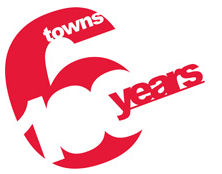31st March 1910 saw the federation of the
six towns to form the County Borough of Stoke-on-Trent
|
Stoke-on-Trent Local
History |
|
|
|
|
| Federation of the six towns 31st March 1910 saw the federation of the six towns to form the County Borough of Stoke-on-Trent |
![]()
![]()
![]()
next: Stoke-on-Trent MP's
previous: Arthur Cholerton
contents: Index page for
Federation


Federation article by local
historian - Fred Hughes
People who made the Potteries - Ted Smith
|
A 1973 Sentinel picture shows a cocky-looking chap being congratulated with a kiss from his wife. He’d just won a seat on the new county council pledging to bring bright ideas into dull local politics. Four years later he was kicked out as Labour’s popularity slumped.
Ted Smith, a Shelton time manager, found himself at the head of the action committee and thrust into national prominence preserved in folklore by a play, ‘Fight for Shelton Bar’, produced by the New Victoria Theatre company. The fight was lost. But the bruising Smith had become addicted to the energy of politics.
In 1982 he became deputy leader of the council and in 1985 joined the management team of the National Garden Festival that ironically transformed the location he’d tried to preserve. Tragically his bright career was interrupted when he fell ill the following year with cancer resulting in a leg amputation in 1988. Most people would have called it a day, but Smith was determined to see his dreams materialise. Support from work colleagues in youth project management helped him back into the council chamber within months of his operation. It was as though he realised his time had arrived, now or never. A year later he was leader of the council.
The cash floodgates opened, and Ted Smith and his officials became phenomenally adept at tapping into regeneration grants particularly from European pots. Together they won significant financial packages although not all the cash was spent wisely. Some, such as the ill-fated Worldgate IT resource, collapsed disastrously. Yet others, such as Trentham Lakes, built on the site of the former colliery, crackled with courageous boldness.
Other triumphant ventures were even more contentious – the financial deal and shared community use of the Britannia Stadium for instance – an inconsistency of policy that rumbles on today. But there’s no doubt the most exciting and the most challenging project of his career was the creation of Stoke-on-Trent’s Cultural Quarter.
The idea of a city centre Cultural Quarter came about in 1992 when Stoke historian, Richard Talbot, formed a charitable trust for the restoration of the disused Regent Theatre. Smith’s plans incorporated this extending it to the refurbishment of the Victoria Hall. It would, he declared, be the showpiece for a city-centre cultural hub attracting international performance and triggering underdeveloped tourism potential. It was a gamble that was likely to attract unprecedented investment if it paid off, but one that held catastrophic consequences if it failed.
Although a massive legal tussle lay ahead, Smith’s cultural plans had succeeded. Yes, his administration was not to everyone’s liking. But no one should doubt that his sharp and often undisciplined vision brought economic and industrial investment to Stoke-on-Trent that many others before him had not seen or not dared to chance. |
![]()
![]()
![]()
next: Stoke-on-Trent MP's
previous: Arthur Cholerton
contents: Index page for
Federation